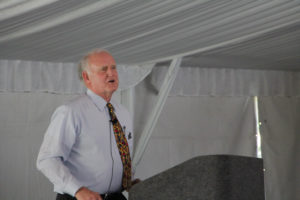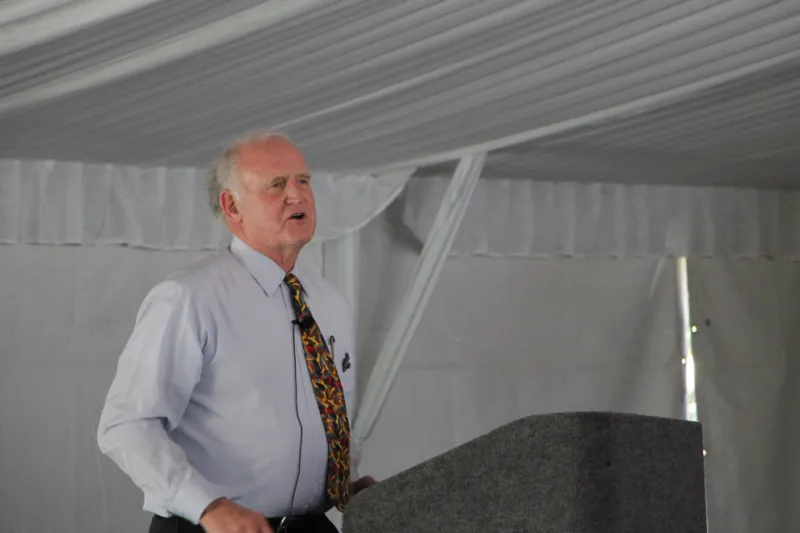Stanford’s Human Biology department celebrated its 45th anniversary and honored the nearly 40-year teaching legacy of professor Bill Durham on Friday. Durham is the Bing Professor of Human Biology, a Bass University Fellow in Undergraduate Education, a senior fellow at the Woods Institute for the Environment and co-director of the Osa & Golfito Initiative. Previously, Durham has taught in the anthropology department and has served as the director of human biology. Durham is set to retire in September of 2018, so the The Daily sat down with Durham to discuss his time at Stanford and the future of the Human Biology program.
The Stanford Daily (TSD): When did you first become interested in evolutionary studies?
Bill Durham (BD): I was very young. I grew up in a place in northern Ohio where there were a number of rivers like the Cuyahoga River that cut through some limestone and shale formations… At an early age I became very fond of fossil collecting, and I found some fossils that adults in my life couldn’t identify. That set me up for a quest to figure out, “What does this [fossil] represent?” I quickly saw that it represented an earlier state in the world, and [I asked], “What was that world like?” And that immediately raised the question, “Why is it different from today?”

My mother said, “You have so many questions; I just don’t know where we’re going to find the answers,” so she took me to librarians and biology teachers, and I kept asking my questions about my fossils… Eventually, she took me to a paperback bookstore, newly opened and bought me a copy of “On the Origin of Species.” She said, “You’re not going to understand all of this now, but this book has most of the answers for you.” [This book from my mother] was a very special possession – I still have it.
TSD: You’ve spoken before about reconciling faith with evolutionary studies. How do you encourage that as an option for students in HumBio as well?
BD: What I try to emphasize is that the tension between the two is largely needless. It’s only if you insist on a very literal interpretation of religious scripts that you get into trouble… There are many people who feel that it’s fair to say that evolution is God’s way of creation… There are faiths that say you can’t accept evolution and follow [their] belief system, but most major religions have found a peaceful resolution. So students aren’t necessarily [as] deeply troubled as they were a decade ago.
I try to be explicit in class, and I tell them, “Look, I’m not asking you to change your faith for this class. All I’m asking is to engage with the ideas, learn what you need to do to solve problems that are articulated in the phraseology of evolutionary thinking [and] learn what evolutionary thinking really means. Then make up your own mind, and I’m happy with that.”
TSD: You took the first introductory Human Biology class ever. Have you noticed a change in the students interested in the Human Biology program at all?
BD: There have been a lot of changes. The interest in those days was inspired by several things: The first Earth Day, the Vietnam War [and] the pressing environmental issues. HumBio promised to be a major that would give students the tools for change [and] for solutions. I think students who were attracted [to HumBio] were those who were activated by the social and environmental problems of the time. Today we attract many students with similar interests, but it’s not quite the same [regarding] the spirit of activism.
TSD: How do you see the Human Biology program changing in the years ahead?
BD: I think with the new president, we’re going to see more of a push towards practical solutions, towards thinking about ways in which Stanford’s intellectual tools can be put to better use for the world. There’s so much of that already happening in the Woods Institute and so on. But I think we’ll even see it more at the department and program level across the university. I wouldn’t be surprised if we don’t see more emphasis in Human Biology on things like practical approaches to emerging infectious diseases [and] the overexploitation of resources on land and at sea.
TSD: What has been one of your most meaningful experiences at Stanford?
BD: Let me mention a couple. When I was relatively young, they asked me to be the director of Human Biology. That was both a huge validation and a big responsibility. I was really pleased because I was able to recruit and hire some wonderful people… I also was able to do a lot of fundraising for the program. For example, I raised a fund called the Bingham Fund for student initiatives, and it’s money that we spend encouraging students to think of some really interesting things to do.
A second thing that I’ve been really happy about is a very interdisciplinary project now in the Woods Institute called “INOGO.” It stands for the Osa & Golfito [Initiative and is centered on] Costa Rica. We were invited to do a sustainability plan for that part of Costa Rica… We have people from the law school, the medical school [and] the humanities and sciences. It’s been great because the collaboration has been especially good. I’m co-director with Rodolfo Dirzo, a professor in biology, and we work really well together. We’ve had wonderful post-docs and research support in Costa Rica and by students here, so that’s been a really rewarding project.
TSD: The HumBio program is pretty unique in its interdisciplinary nature, but there are other cultural biology programs out there – how is Stanford’s program different?
BD: What’s nice about HumBio is it’s not a department; it’s a program. It brings people from schools and departments to teach the kinds of material and offer the kinds of training that we think should be done to work on the world’s problems… There was [also] a lot of wisdom in putting together the program… The founders of Human Biology had the sense to put some perpetuity behind the faculty [by using endowed] professorships. These faculty have provided a backbone. We’re the stable elements of the [Human Biology] Core courses year after year, and I think that was really important. The Core does change, but only in small ways from year to year. It changes when more people retire … and surely that’s all [for] the better.
One of my motivations for retiring was that I think they should have more young people in HumBio, and we older folks need to make way for young people. I was 27 when I was hired in HumBio… You come in with so much energy and enthusiasm. I invited students to [help] me with lactose and sickle cell [research], and pretty soon there were 41 people helping with various projects that became [my] book on coevolution. I couldn’t imagine working with 41 people at the same time today. It takes so much energy and you pretty much work 20-hour days to stay ahead. I’d like to see HumBio get that fresh energy again — new people don’t have to be young necessarily, but they need to be people with new approaches, big ideas and lots of energy.
This transcript has been condensed and lightly edited.
Contact Tia Schwab at kbschwab ‘at’ stanford.edu.
